Trading cryptocurrencies is indeed more profitable than trading stocks. If your capital is within 100,000, there is a very simple method to trade cryptocurrencies that allows you to maintain 'eternal profits' in the crypto world!
Everyone doesn't have to worry about whether you can learn it. I can seize this opportunity, and so can you. I am not a god, just an ordinary person. The difference between me and others is that others have overlooked this method. If you can learn this method, in future trading, it can help you earn at least 3 to 10 points of profit every day.
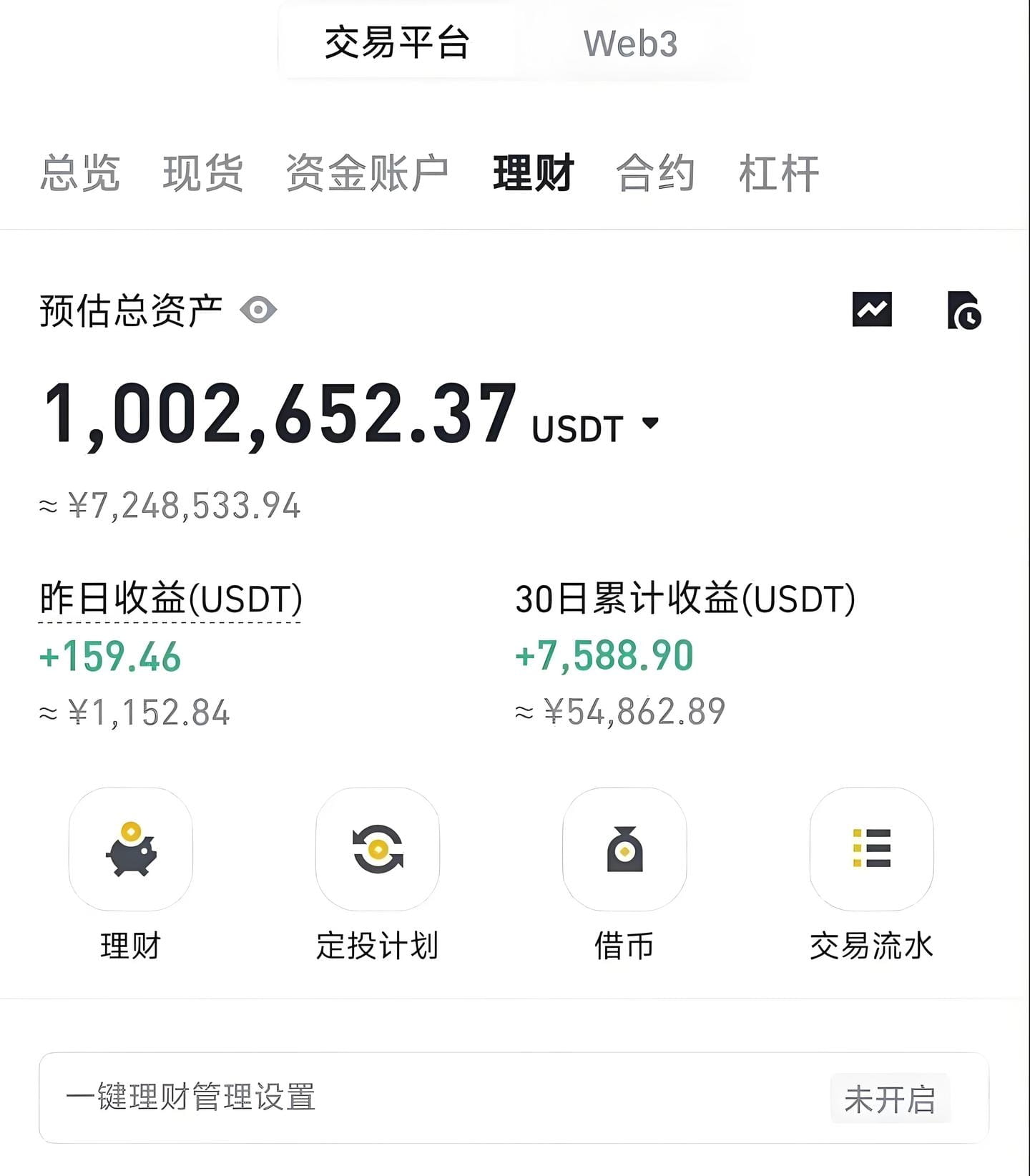 Welcome everyone to my knowledge sharing series. The purpose of this series is to gradually lead everyone to learn and judge various situations in the market.
Welcome everyone to my knowledge sharing series. The purpose of this series is to gradually lead everyone to learn and judge various situations in the market.
The outline for sharing knowledge can be summarized as: starting from the bottom indicator area, then guiding everyone to understand the candle chart in the price trend area, interspersed with learning some macro concepts such as Dow Theory, Elliott Wave Principle, etc.
Looking at the entire analysis chart, it is mainly divided into price trend area and indicator area. We will gradually lay the foundation for everyone; the main content of the first sharing is the MACD indicator.
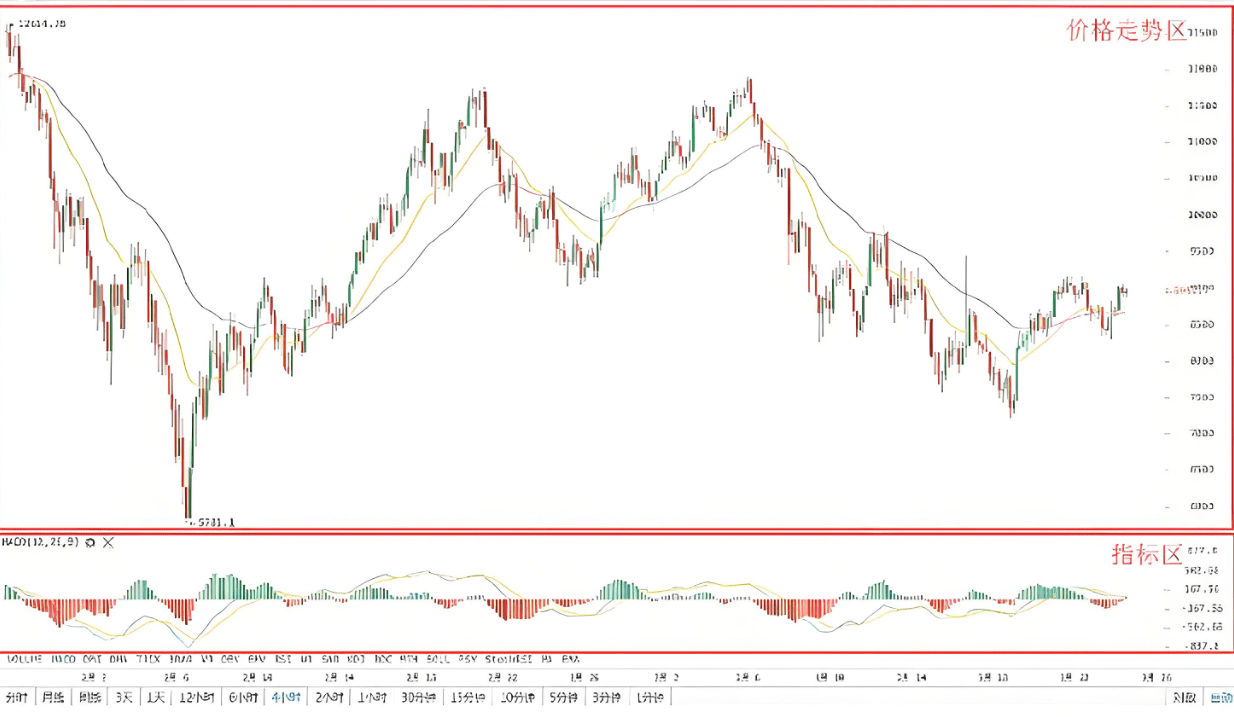 The MACD indicator, also known as the Exponential Moving Average Convergence Divergence, is developed from the double exponential moving average. Simply put, it reflects the aggregation and separation between short-term and long-term moving averages, representing the current bullish and bearish state and potential trends in stock prices for easier reading. We often mention MACD in Xiao Fang's essays.
The MACD indicator, also known as the Exponential Moving Average Convergence Divergence, is developed from the double exponential moving average. Simply put, it reflects the aggregation and separation between short-term and long-term moving averages, representing the current bullish and bearish state and potential trends in stock prices for easier reading. We often mention MACD in Xiao Fang's essays.
MACD consists of the blue line DIF, the yellow line DEA, and the histogram. With the zero axis as the central axis, above 0 indicates strength and below 0 indicates weakness. When the blue line crosses above the yellow line, it is a golden cross; when the blue line crosses below the yellow line, it is a death cross.
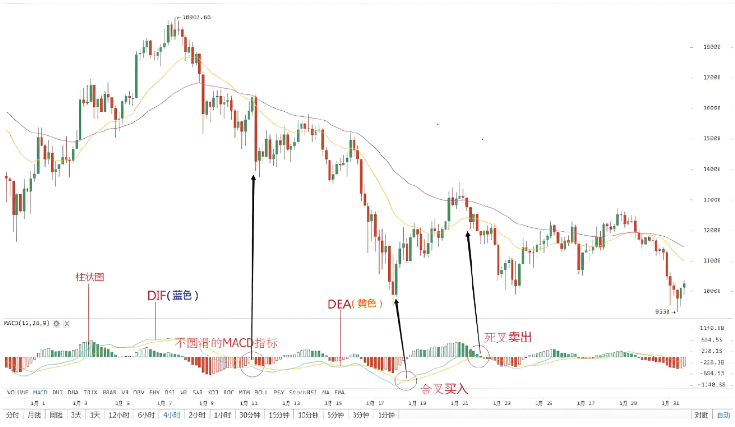
1. In theoretical knowledge, when the MACD shifts from negative to positive, it is a buy signal. When the MACD shifts from positive to negative, it is a sell signal. When the MACD changes at a large angle, it indicates a very rapid widening of the gap between the two moving averages, representing a major trend change in the market.
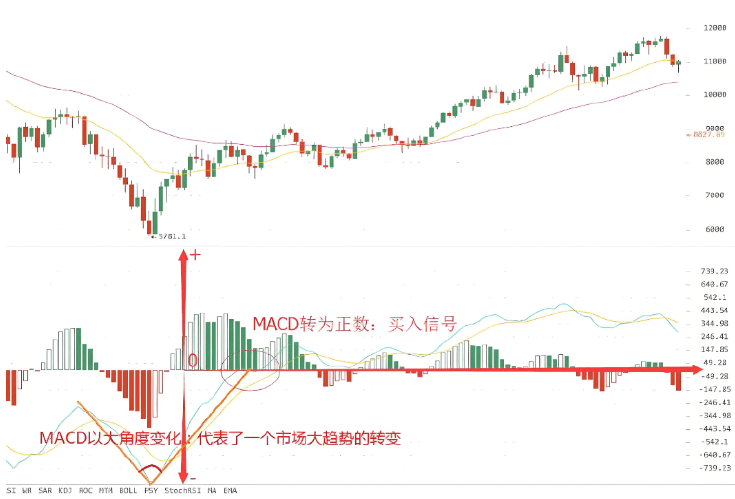
In actual operations, MACD has two main functions: one is to judge trends, and the other is to determine pullbacks or reversals through divergence.
1. Buy on golden crosses, sell on death crosses.
In simple terms, it means chasing highs and cutting losses. In a bullish market, buy on golden crosses, and in a bearish market, sell on death crosses. However, in actual operations, it often requires anticipating golden and death crosses. But the big players certainly won't make it easy for you to analyze the trend; further actions need to be made in conjunction with other indicators.
2. Sell at top divergence and buy at bottom divergence.
Under normal circumstances, the MACD indicator should move with stock prices. However, due to certain factors, sometimes the indicator fails to synchronize with the price, which is what everyone often sees as divergence. Simply put, divergence occurs when there is a difference in movement between price and indicator.
Mainly divided into two types:
(1) Top divergence: Prices reach new highs while the MACD indicator declines.
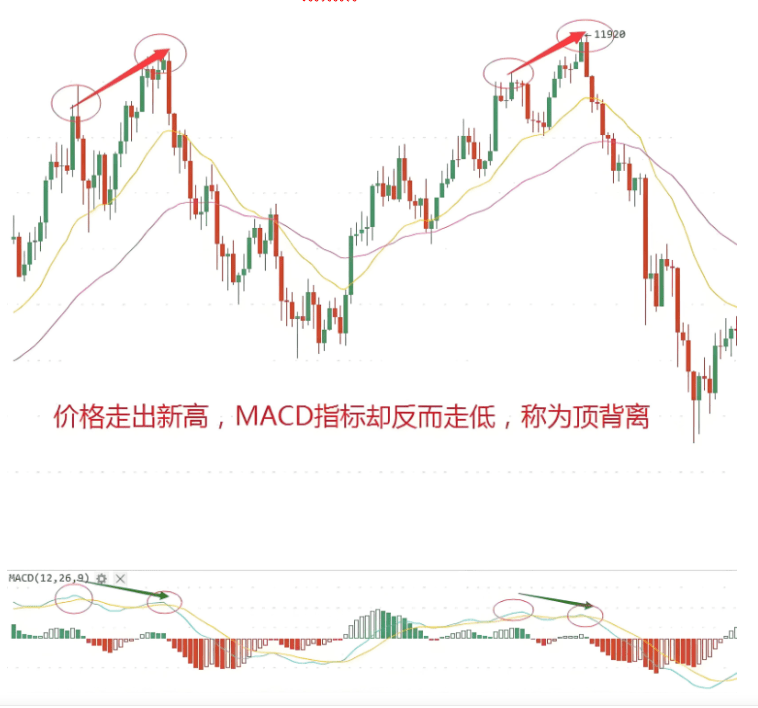 (2) Bottom divergence: Prices fall while the MACD indicator rises.
(2) Bottom divergence: Prices fall while the MACD indicator rises.
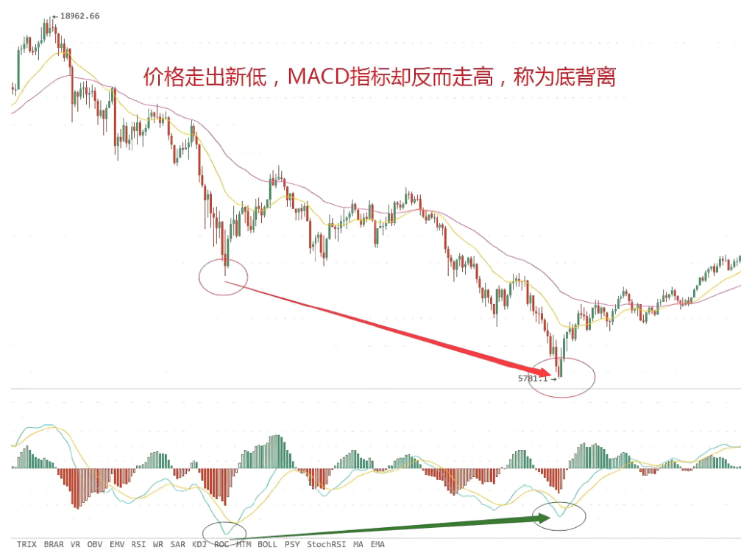 In actual operations, it is often summarized as escaping the top and buying the bottom. Sell at top divergence and buy at bottom divergence. In a rising market, prices continuously hit new highs, and moving averages are perfectly aligned in a bullish arrangement. If only looking at price and moving averages, it seems that the upward trend has not yet reached its end. However, after multiple waves, it seems that some changes occur. The MACD top divergence often reminds everyone that such a trend might end at any time.
In actual operations, it is often summarized as escaping the top and buying the bottom. Sell at top divergence and buy at bottom divergence. In a rising market, prices continuously hit new highs, and moving averages are perfectly aligned in a bullish arrangement. If only looking at price and moving averages, it seems that the upward trend has not yet reached its end. However, after multiple waves, it seems that some changes occur. The MACD top divergence often reminds everyone that such a trend might end at any time.
MACD is a commonly used technical indicator; almost every financial product's trading interface shows MACD as the first auxiliary chart. The fact that so many people use it indicates it is indeed useful. Moreover, the more people use it, the more it forms feedback to the market. When everyone sees this signal, they will act based on it, and their actions will feedback to the market, causing this signal to truly drive market fluctuations. Therefore, regardless of whether you are a technical trader, you must have a detailed understanding of MACD.
The basic use of MACD can be found by everyone, so I won't elaborate here. However, everyone has noticed that those textbook-style teachings may seem like truths, but they often do not lead to profits. This is because the authors of these books are eliminated by the market; they write books because they cannot make money in the market. Here, I will share some real practical applications.
Advantages and disadvantages of MACD
To understand an indicator, one must first know its advantages and disadvantages, when it cannot be used, when it is ineffective, and when it is best used. MACD is a trend indicator; its advantage is a very high accuracy rate, but its shortcomings are also quite evident, being severely lagging. With high accuracy, we can use it as a trend indicator, and the accuracy over long periods is even higher, only showing errors during market transitions. The severe lagging shortcoming indicates that it is difficult to find perfect buy and sell points using this indicator. If using MACD to find buy and sell points, one must be clear that we are only catching the fish belly, or even just a part of it. Only by clarifying this can we use MACD to find buy and sell points.
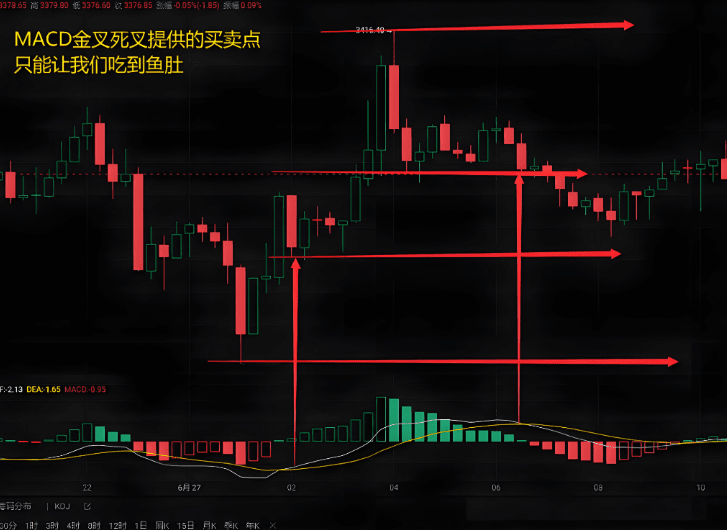 Zero Axis
Zero Axis
The MACD zero axis can be seen as the boundary line between bullish and bearish. Below the zero axis indicates a bearish trend, and bullish signals should be avoided. Even if you enter, it should be with a small position, quickly in and out. Bearish signals can be held in trend. Conversely, above the zero axis. The golden crosses and death crosses formed near the zero axis are referred to as zero axis golden crosses and zero axis death crosses, which are more effective bullish and bearish signals.
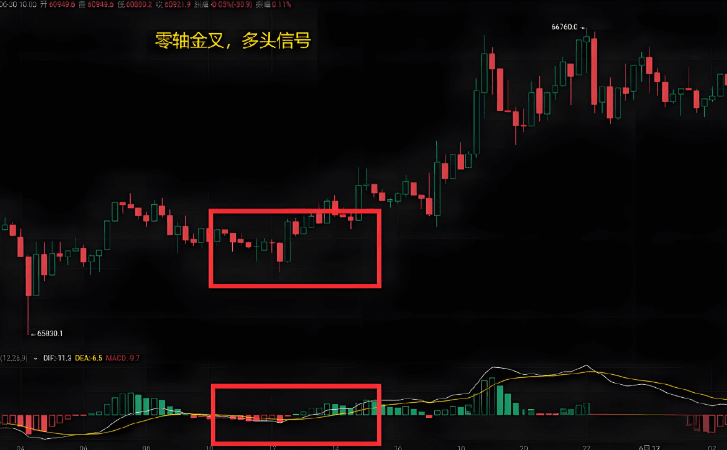
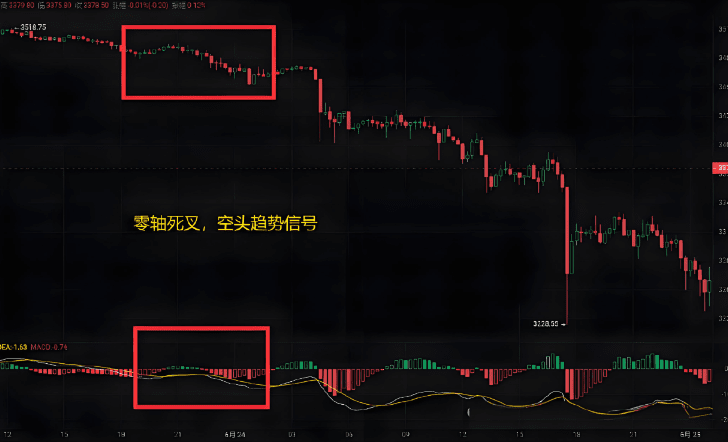 Divergence
Divergence
Divergence is a relatively practical form of MACD. Normally, price and indicators are proportional, but when the price and indicator continuously move in opposite directions, it indicates divergence. When something unusual happens, there must be something amiss; if the price rises while the indicator falls, it indicates that this rise is problematic, and the same applies to bottom divergence.
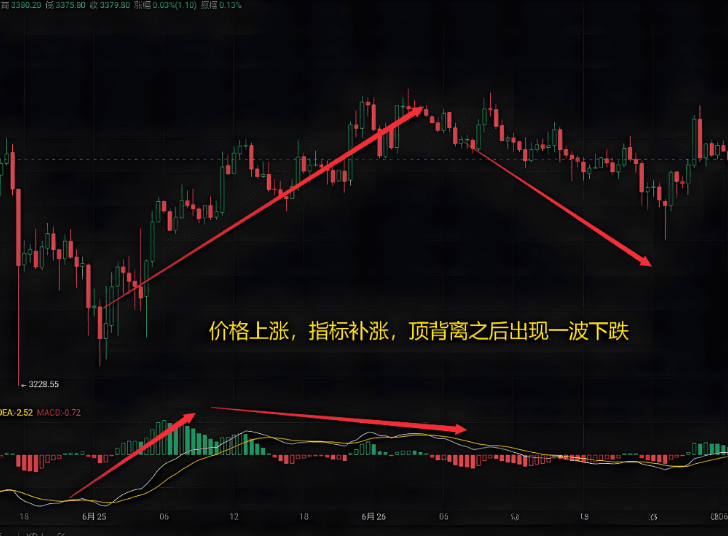 It should be pointed out that the cryptocurrency market occasionally sees low-probability one-sided trends. During these times, divergence becomes ineffective. This can be easily excluded by observing strength; when the strength of rise or fall is very high, the so-called strength refers to extremely rapid surges or drops, indicating that this is controlled by the main players. At this time, technical indicators become ineffective, and even the most accurate divergences will continue to diverge.
It should be pointed out that the cryptocurrency market occasionally sees low-probability one-sided trends. During these times, divergence becomes ineffective. This can be easily excluded by observing strength; when the strength of rise or fall is very high, the so-called strength refers to extremely rapid surges or drops, indicating that this is controlled by the main players. At this time, technical indicators become ineffective, and even the most accurate divergences will continue to diverge.
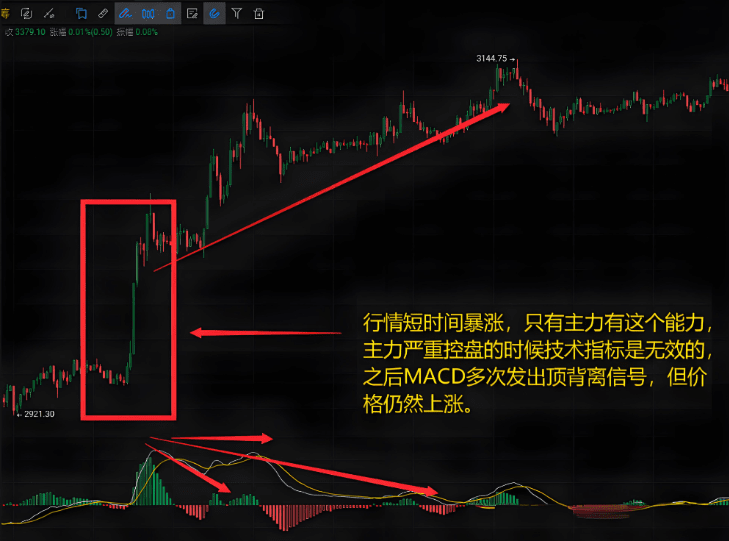 Technical indicators are tools for observing the market. Since everyone is watching them, it indicates they are useful. Even if they are not, because investors are looking at them, they will become useful since the market itself is determined by the behavior of countless investors. However, everyone should note that many times, technical indicators are ineffective or poorly used. Every technical indicator has its shortcomings; the more useful the indicator, the more apparent its shortcomings. Learning to use a technical indicator requires understanding its weaknesses and leveraging its strengths to bring us stable returns.
Technical indicators are tools for observing the market. Since everyone is watching them, it indicates they are useful. Even if they are not, because investors are looking at them, they will become useful since the market itself is determined by the behavior of countless investors. However, everyone should note that many times, technical indicators are ineffective or poorly used. Every technical indicator has its shortcomings; the more useful the indicator, the more apparent its shortcomings. Learning to use a technical indicator requires understanding its weaknesses and leveraging its strengths to bring us stable returns.
In summary, the MACD indicator is quite significant, but because the trend is often subject to deliberate manipulation, beginners are often misled. To emphasize again, we need to combine it with other indicators for further actions. To talk further, we need to take a macro perspective; one must not focus solely on a single indicator. This is something everyone must remember.
Continuing to share a set of (Candle Chart Essentials) K-line patterns!
The introduced patterns are actually two types of double-day reversal patterns formed by the different positions of a K-line type in different market contexts, which are the Inverted Hammer and the Shooting Star.
From the following diagram, we can see that whether it is the Inverted Hammer or the Shooting Star, in terms of a single K-line, the forms are the same, with the only difference being their positions in different market contexts (pp.43):
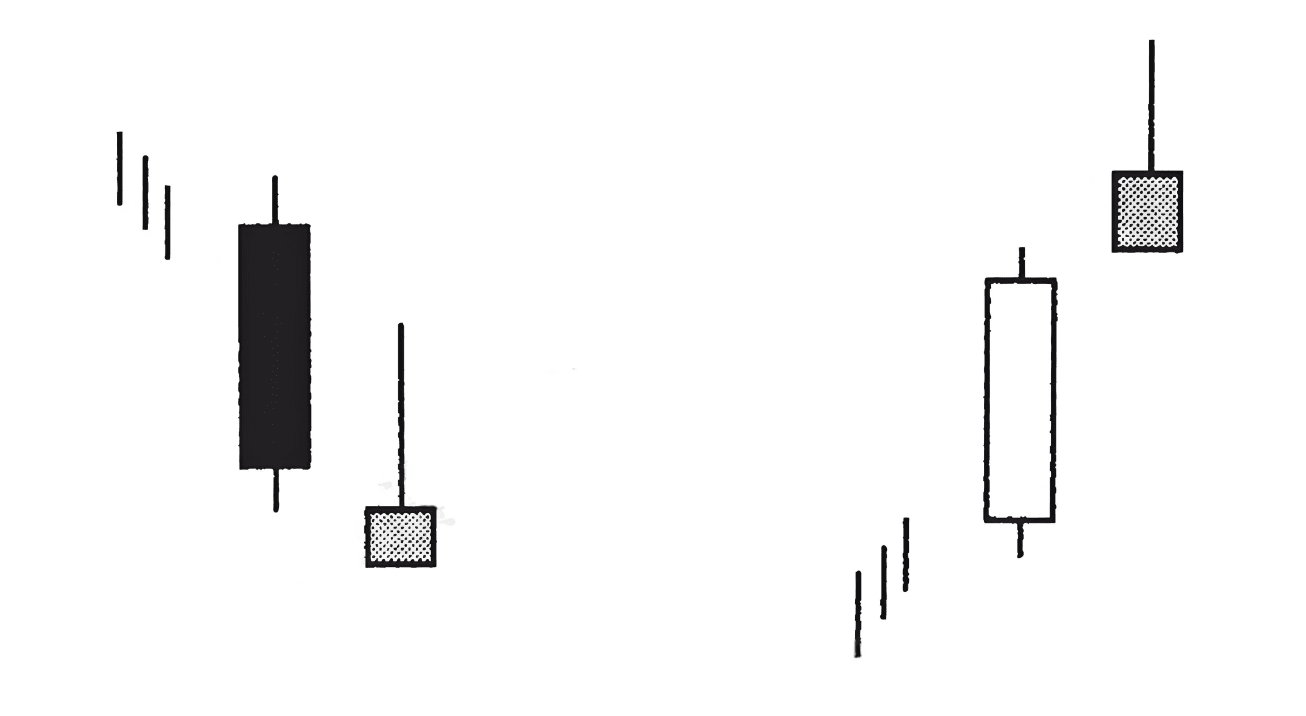 The occurrences of the Inverted Hammer and Shooting Star in the market, along with their win rates and odds, are summarized in the following table (pp.42):
The occurrences of the Inverted Hammer and Shooting Star in the market, along with their win rates and odds, are summarized in the following table (pp.42):
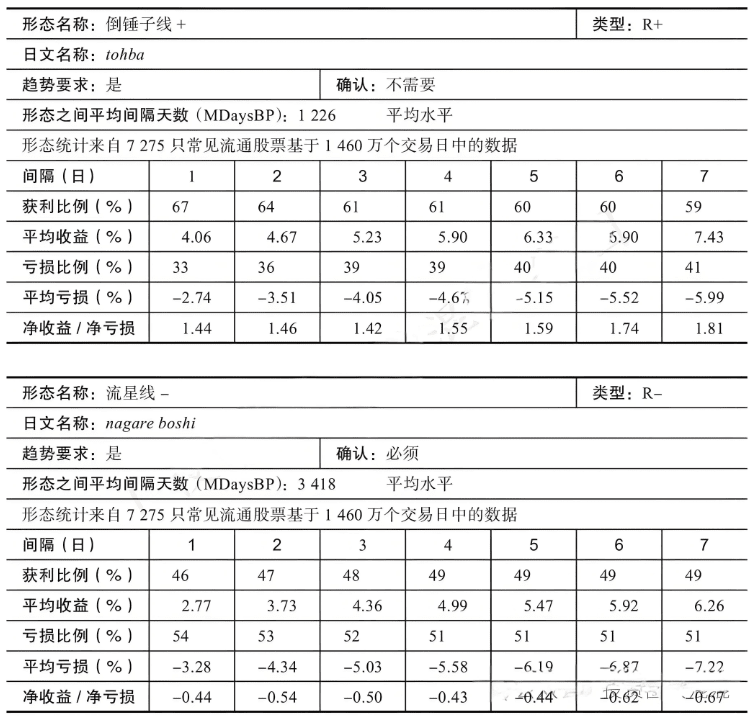
The recognition criteria for the Inverted Hammer are as follows:
The small body appears at the lower end of the daily price range.
In a downtrend, there is no need for the pattern to show a downward gap; as long as the overall pattern points downwards, it can be judged as an Inverted Hammer pattern.
The length of the upper shadow usually does not exceed twice the length of the body.
There are no lower shadows on the candle chart. (pp.43)
The recognition criteria for the Shooting Star are as follows:
In an upward market trend, an upward gap occurs at the opening.
The small body appears at the lower end of the daily price range.
The length of the upper shadow is at least three times the length of the body.
There are no lower shadows on the candle chart. (pp.43-44)
We can find that there are some differences in pattern recognition between the Inverted Hammer and the Shooting Star. The Inverted Hammer does not require a gap, while the Shooting Star must have one, and the upper shadow of the Shooting Star is required to be longer than that of the Inverted Hammer.
These differences actually depend on the trading context and market psychology analysis behind the formation of these two patterns. The formation of the Inverted Hammer is due to:
Inverted Hammer pattern: The market is originally running in a determined downtrend, but suddenly within a trading day, a downward gap is formed between the opening price and the previous day's closing price. The market fails to advance and ultimately closes at a lower price. Just like the Hammer pattern and the Hanging Man pattern, the following day's market trend is key to judging whether the market can successfully reverse. If the opening price the next day is higher than the highest price of the Inverted Hammer's body, it indicates a potential reversal, leading short-term bears to start going long, which further stimulates the price to continue rising. (pp.44)
The formation of the Shooting Star is due to profit-taking and securing gains:
In an upward trend, the market has an upward gap, and prices reach a new high, but the upward trend lacks support, causing prices to start to pull back, closing slightly higher than the opening price. This upward gap opening followed by a downward trend can only be identified as a bearish pattern. Undoubtedly, this trend will stimulate profit-taking by the bulls to secure gains. (pp.44)
The body color and shadows of the Inverted Hammer and Shooting Star are both very important because:
The length of the shadow will determine the strength of this reversal pattern. The length of the upper shadow should be at least twice the length of the body, and preferably there should be no lower shadow. Even if there is a lower shadow, its length should not exceed 5% to 10% of the body length. Similar to most cases, the color of the candle body can help us better understand the actual emotions of traders in the market. (pp.44)
Regarding the simplification of patterns, both the Hammer and Shooting Star have points to note:
The Inverted Hammer pattern can be simplified to a large bearish candle (see the left side of the diagram below). If only considering the simplified figure, it will certainly have a bearish tendency; the Shooting Star pattern can be simplified to a large bullish candle (see the right side of the diagram below). If only considering the simplified figure, it will certainly have a bullish tendency. At this point, we find that the restored candle chart patterns contradict their original meanings, so in practical application, we need to combine with the subsequent market trends for further confirmation. (pp.44-45)
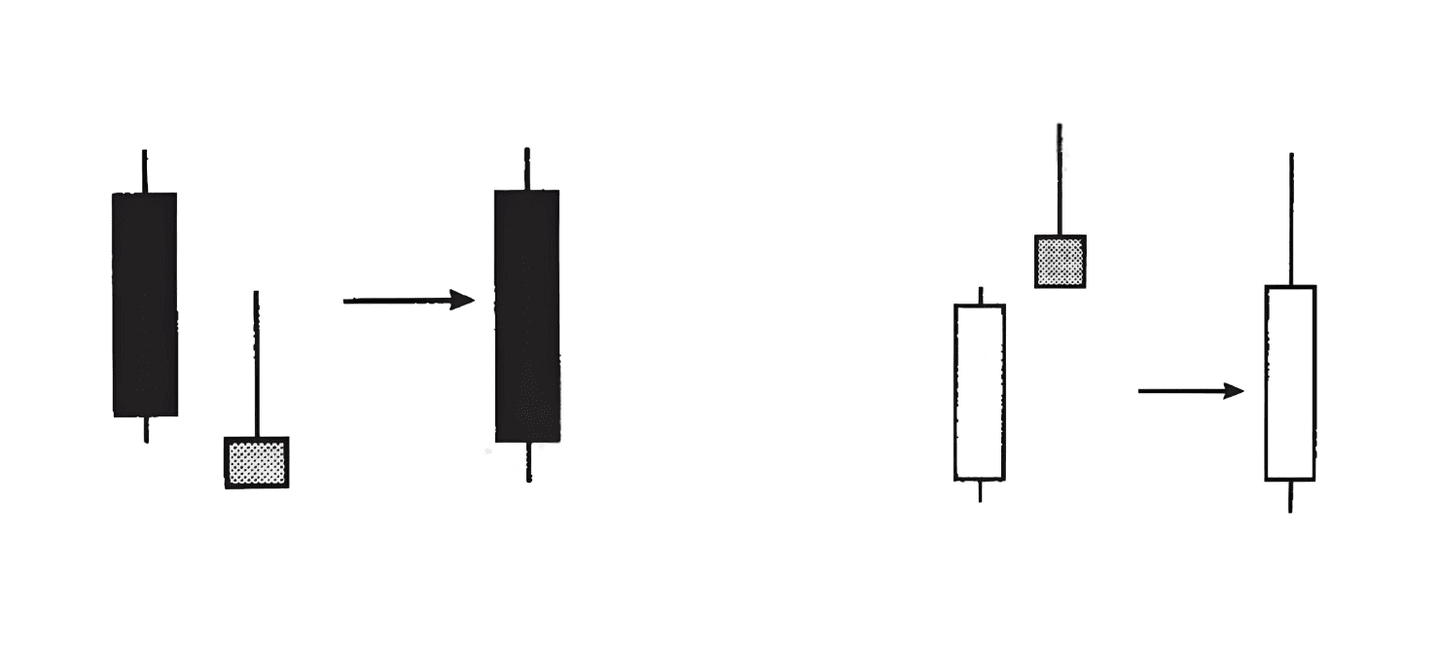 It should be noted that in the summary table of the Inverted Hammer and Shooting Star patterns, we can see that the Inverted Hammer does not require confirmation, but the Shooting Star must be confirmed, indicating that compared to the Shooting Star, the success rate of the Inverted Hammer is higher.
It should be noted that in the summary table of the Inverted Hammer and Shooting Star patterns, we can see that the Inverted Hammer does not require confirmation, but the Shooting Star must be confirmed, indicating that compared to the Shooting Star, the success rate of the Inverted Hammer is higher.
The pattern related to the Inverted Hammer and Shooting Star is the Gravestone Doji.
The actual market charts for the two patterns are as follows (pp.46):
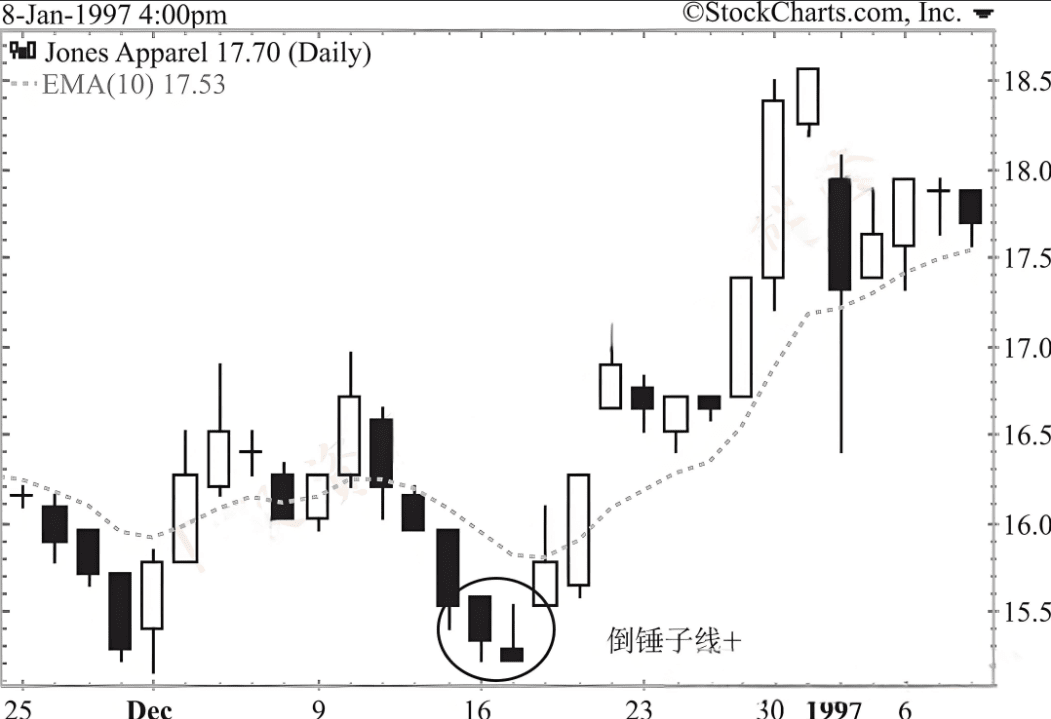
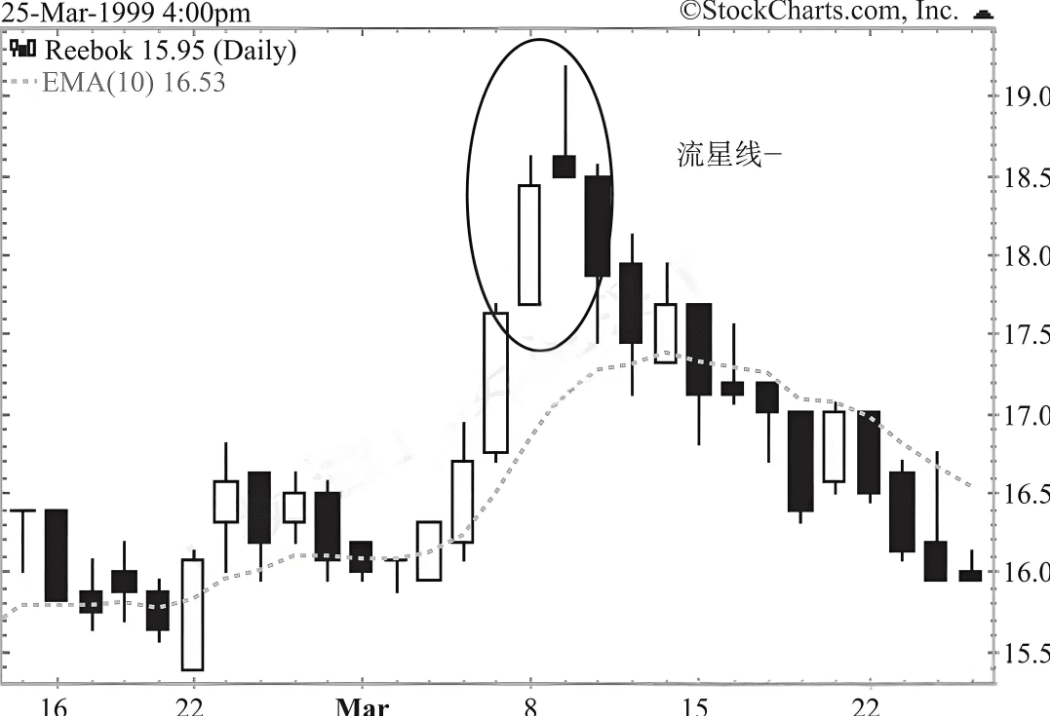 The above are the Inverted Hammer and Shooting Star from the double-day reversal patterns.
The above are the Inverted Hammer and Shooting Star from the double-day reversal patterns.
Finally! After these years, I have summarized six ironclad rules! I hope they help everyone!
1. Only participate in trends that are irreversible. Only participate in trends that are irreversible; the market is reality, it cannot be doubted or challenged. Trends are irreversible. As an investor, one must dare to recognize mistakes, correct them at any time, reject uncertain trends, and engage in trends that even the big players must follow; one must understand to follow the trend.
2. Refuse frequent trading. The casino is open 24 hours; there is no need to trade frequently. There are many logics such as timing, trial and error, position control, etc. We advocate waiting like a hunter for the perfect opportunity, rather than randomly investing whenever we see prey.
3. Do not be superstitious about technical indicators. First, we must acknowledge that any technical indicator has its lagging nature. For example, when the MACD indicator issues a golden cross buy signal, the coin has already risen in advance, and at the moment the golden cross occurs, you might very well be the one left holding the bag.
4. Buy and forget about the cost price. Once you start shorting or going long, the cost price has no relation to any subsequent operations because whether to sell depends on the market trend, which has no relation to whether you are still making profits. If the pattern is good, continue to hold. If the pattern is bad, reduce your position or even close your position.
5. Participate with money you can afford to lose. Use spare cash to trade cryptocurrencies; investing always carries risks. Investors can increase their investment after mastering the game of profit generation. Before that, always participate with money you can afford to lose; borrowing money often leads to disastrous losses.
6. Withdraw profits on time: Without withdrawals, everything is just numbers. Investors in the cryptocurrency world are like gamblers who haven't left the casino; even if they temporarily earn a lot of money, they cannot be considered winners. Only when you extract cash from the market can you say you laughed last. In the cryptocurrency world, withdrawing profits on time is a good habit.
The above are some of Xiao Yue's personal views and insights. If you find them helpful, feel free to like and save them. I am Xiao Yue, someone who has gone through three rounds of bull and bear markets, skilled in logical coin selection and technical timing, trading only within my knowledge range, with every direction validated by the market!
#加密市场回调 $ETH